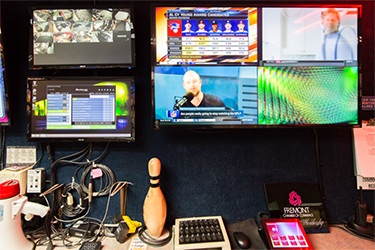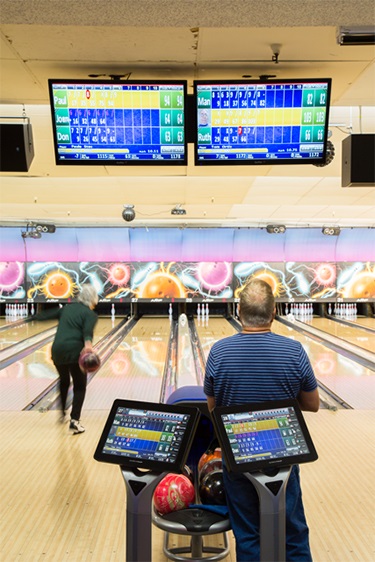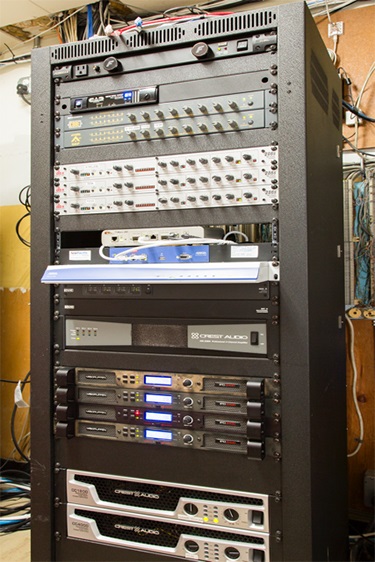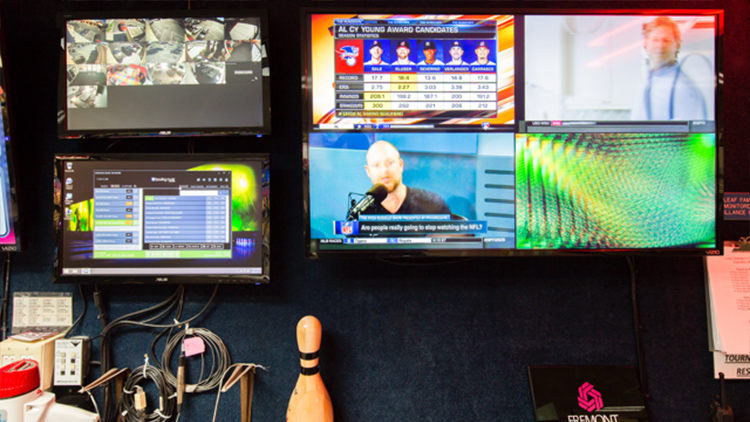Located in Fremont, CA, the Cloverleaf Family Bowl has something for everyone. In addition to 44 lanes of bowling action, Cloverleaf hosts local bowling leagues, birthday parties, special events, and even community fund-raisers for worthy causes. Add Cloverleaf’s accessibility for physically disabled bowlers, and this is a recreational facility on top of its game—including the use of 21st century AV technology to keep bowlers informed and entertained.

Now Cloverleaf Family Bowl wasn’t always a beacon of advanced AV. In fact, before Cloverleaf owner Jim Chambers called Bruce Green of Arete Audiovisual Design of Brentwood for help, this family bowling alley was a bit of an AV wasteland.
For instance, the music volume over Cloverleaf’s loudspeakers had to be kept almost inaudibly low, due to fears of putting the amplifiers into overload and shutting down. The video on the old SDTVs around the Cloverleaf facility got fuzzier the further you got away from the original distribution point. And if you wanted to change the channel on one of three DIRECTV SDTV satellite tuners (all connected to one dish), you had to turn two of them off, in order to use the remote to control the third one.
Striking the Right Balance
“This was one seriously impaired AV installation, the result of poor initial design and years of handyman add-ons without any kind of integration plan,” said Green. “This made bringing Cloverleaf Family Bowl’s AV installation to a professional 21st century level a really big challenge, to put it mildly.”
Initially, Bruce Green was brought in to address problems with Cloverleaf’s paging system. His success resulted in Chambers hiring him to fix the bowling alley’s problem-plagued audio and video distribution/playback systems. Here’s how Green did it.
Phase One: Can You Hear Me Now?

According to Bruce Green, Cloverleaf’s original multi-zone paging and music systems were installed by two independent contractors. “The multi-zone paging system was installed using 8-inch ceiling speakers, a Penton Audio DSP processor and Penton Audio compact 15 watt/70-volt amplifiers and digital processor,” Green said. “The front desk and food prep areas each utilized Penton Audio push-button zone controllers for multi-zone paging functions.”
Cloverleaf’s original music system was comprised of 16 Renkus-Heinz CFX121-8 two-way speakers and five Renkus-Heinz CFX12S-8 subwoofers. It was powered by four Crest Audio CC4000 dual-channel amplifiers.
The paging system’s problem was due to processor problems. “For some reason, the existing Penton Audio processor couldn’t be updated,” said Green. “This meant that the system locked up when they tried to page someone within one of Cloverleaf’s 12 paging zones.”
Fixing the paging system was easy, especially because Green had worked with Penton Audio paging technology in the past. “I just pulled the old processor out, put a new one in, and it worked,” he said. “But fixing the music playback system? That was something else entirely.”
The problem: The Cloverleaf music system’s speakers were wired for mono reproduction using the old 16-gauge wiring from an earlier installation. Using this too-thin wire over the 250’ foot runs resulted in a voltage drop, effectively reducing the watts being delivered to the furthest speakers. Additionally, the existing wiring could not accommodate the number of speakers installed, which created an inefficient 2-ohm load at the amplifiers. In fear of overloading the Crest Audio amplifiers, “the Rane Digital processor was programmed to limit the SPL to marginal output levels,” said Green.

To resolve this problem, a total rewiring of the speakers was required using a larger 12-gauge wire. This increased the efficiency of the system by lowering the voltage-drop at the speakers, raising the impedance to a safe 4-ohm load and enabling quasi-stereo music reproduction. Four Lab Gruppen IPD2400 amplifiers, two Penton Audio UAP-G2 digital processors and a Furman P-8 Pro Series II power conditioner were integrated into the system to complete the upgrade. The four existing Crest Audio CC4000 dual-channel amplifiers were repurposed as subwoofer amplifiers.
To allow Cloverleaf to pump out loud music with solid bass, Bruce Green connected four more Renkus-Heinz CFX12S-8 subwoofers to the new music system. He also integrated paging into the system by adding two Penton Audio PPM-8 paging stations, three dbx 286s microphone preamps, and a Shure 515SBG-18x paging microphone at the front desk. “It just made sense to combine music and paging together,” Green said.
Phase Two: Fixing the Picture
Having revitalized Cloverleaf’s music/paging systems, Bruce Green was hired to bring HDTV to the bowling alley—and to banish fuzzy video pictures once and for all.
He began by looking at what was in place. “The existing RF system incorporated three Holland Electronics analog RF modulators, three standard-def DIRECTV receivers, one DVD player, and music videos from The Bowling Music Network computer,” Green said. “Seventeen 27-inch and three 40-inch flat-screen SDTVs, along with four Vivitek projectors, displayed all the video/satellite TV information.”
So why was the picture quality still subpar? It was due to “splitters upon splitters upon splitters being added to the RF network over time to serve additional TVs,” Green replied. “The final result was a fuzzy video image on the flat-screen TVs. The RF signal level at the last TV was -20dB.”

To resolve Cloverleaf’s RF distribution problems, Bruce Green selected Contemporary Research’s RF distribution equipment. “I chose Contemporary Research because of the quality of their products and their experience in the industry,” he said. “Additionally, Contemporary Research’s RF-based control system is a unique product that other manufacturers cannot compete with.”
Ultimately, Green installed two Contemporary Research QMOD-HDMI 2/HDTV modulators, four Contemporary Research ICC2-ATSC 4 HDTV/HD tuner controllers, and 23 Contemporary Research ICC1-IRX TV/TV controllers to feed 22 Vizio 32-inch Flat-screen HDTVs and three Vizio 40-inch flat-screen HDTVs. The new RF system also includes a Contemporary Research QDA4-45/RF amp combiner, a Contemporary Research ICE-HE Ethernet/Ethernet headend controller, and a Gefen EXT-HD-MVSL-441 multi-viewer. This last device provides a quad view of the three DIRECTV feeds and the Bowling Music Network video stream on a front desk monitor.
As well, Green installed three DIRECT HD satellite receivers—each with its own uniquely addressed code—a DIRECTV HD satellite dish, and a Denon Blu-ray player. The system is controlled by an RTI touch screen controller. “For our next phase, Cloverleaf owner Jim Chambers is considering upgrading the four Vivitek Projectors and screens,” he said.
Today, Cloverleaf Family Bowl’s AV system delivers clear paging messages, booming music, and crystal-clear HD video throughout the facility. “When it comes to measuring the success of a project,” Bruce Green observed, “it all comes down to the Big Smile on the owner’s face when you hit the switch and it all works!”
James Careless is a frequent contributor to AV Technology magazine.
Equipment List
- Contemporary Research QMOD-HDMI 2/HDTV modulators
- Contemporary Research ICC2-ATSC 4 HDTV/HD tuner controllers
- Contemporary Research ICC1-IRX TV/TV controllers
- Contemporary Research QDA4-45/RF amp combiner
- Contemporary Research ICE-HE Ethernet/Ethernet headend controller
- Crest Audio CC4000 dual-channel amplifiers
- dbx 286s microphone preamps
- Denon Blu-ray player
- DIRECT HD satellite receivers
- Furman P-8 Pro Series II power conditioner
- Gefen EXT-HD-MVSL-441 multi-viewer
- Lab Gruppen IPD2400 amplifiers
- Penton Audio PPM-8 paging stations
- Penton Audio UAP-G2 digital processors
- Rane Digital processor
- Renkus-Heinz CFX12S-8 subwoofers
- RTI Touch Screen controller
- Shure 515SBG-18x paging microphone
- Vivitek Projectors
- Vizio 32-inch and 40-inch flat-screen HDTVs

